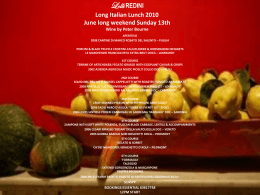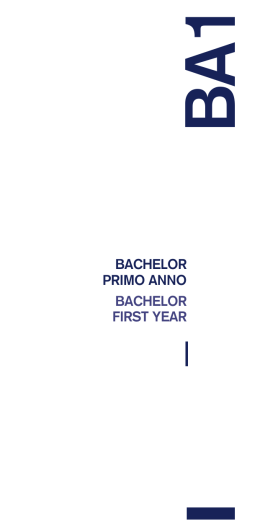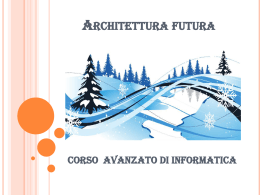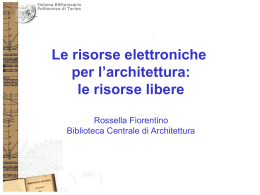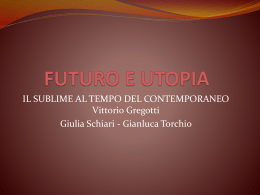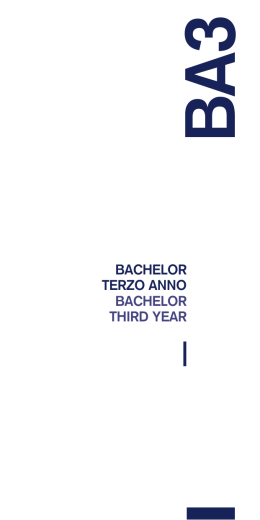BA2 BACHELOR SECONDO ANNO BACHELOR SECOND YEAR BA2 atelier di progettazione design studios BA2 Atelier di progettazione Design Studio The second-year studio offers the opportunity to consolidate the knowledge acquired in the first year, gain experience of fundamental issues in architecture and finally enable the student to explore the methods of professional practice. Each studio session will work on a housing project, one of the commonest and most representative topics in professional practice, on which the students have acquired a certain personal experience. One semester will be devoted to studying and analysing collective housing with its specific and exclusive issues; in the second semester the individual house will offer the opportunity to deal with a personalized brief, with the specifics of landscape and topography, as well as the materialization of architecture and the constructional detail. A course in the Theory of Housing and a seminar in Construction and Design will complete the studio program. SEM IT / EN ORE/HOURS 224 + 224 L’atelier di secondo anno offre l’occasione di consolidare le conoscenze acquisite nel primo anno, familiarizzare con le questioni fondamentali dell’architettura e finalmente avvicinare lo studente ai metodi della pratica professionale. Ogni atelier svolgerà un progetto di housing, tema tra i più consueti e rappresentativi della pratica professionale, in merito al quale ciascuno studente ha acquisito una certa esperienza personale. Un semestre sarà dedicato allo studio e all’analisi della residenza collettiva nella sua problematica specifica ed esclusiva; nell’altro semestre l’abitazione individuale offrirà l’occasione per confrontarsi con un programma personalizzato, con le specifiche del paesaggio e della topografia, nonché con la materializzazione dell’architettura e il dettaglio costruttivo. Un corso di Teoria dell’housing e un seminario di Costruzione e progetto completano il programma dell’atelier. LINGUA/LANG. ECTS 15 + 15 Walter Angonese Valentin Bearth Marc Collomb (coord.) José Maria Gil I + II Progetto: Housing Project: Housing 43 BA2 discipline storico-umanistiche historical-humanistic courses BA2 Corso obbligatorio: Teoria dell’arte e dell’architettura Compulsory Course: Theory of Art and Architecture This course is based on the assumption that, along with the “end of natural history”, in the 18th century a cultural shift took place which had a consequential impact on architecture. From that point forward, issues of cultural adaptation, contemporary behavior and advancement have significantly influenced architectural practice and theory. Within this framework the course will encompass threads of architectural development, chiefly in the Western world, from the later Age of Enlightenment up to the 1970s including outlooks to contemporary conceptions. It deals with social, economic, political conditions of architecture as well as aesthetic, material, and technical aspects. As a general approach architectural objects will be interpreted as outcomes of socio-cultural processes and conceptions. SEM EN ORE/HOURS 24 + 24 Il corso si fonda sul presupposto che nel Settecento, insieme con la “fine della storia naturale”, abbia avuto luogo un cambiamento culturale che ha agito anche sulla produzione architettonica. Da qui in avanti, questioni quali l’adattamento culturale, il comportamento e il progresso esercitano un influsso significativo sulla pratica e la teoria dell’architettura. In questo quadro, il corso analizza gli sviluppi dell’architettura, soprattutto nel mondo occidentale, dall’età dei Lumi fino agli anni Settanta del Novecento e alle concezioni contemporanee. Tratta le condizioni sociali, economiche e politiche dell’architettura, così come i suoi aspetti estetici, materiali e tecnici. In generale, l’oggetto architettonico viene interpretato come il risultato di processi e concezioni socio-culturali. LINGUA/LANG. ECTS 2.5 + 2.5 SA/HA Sonja Hildebrand I + II Architettura moderna: XIX e XX secolo 1 e 2 Modern architecture: 19th and 20th centuries 1 and 2 45 BA2 Corso obbligatorio: Teoria dell’arte e dell’architettura Compulsory Course: Theory of Art and Architecture Arte e architettura del Medioevo Art and Architecture in the Middle Ages 24 ORE/HOURS IT LINGUA/LANG. 2.5 ECTS SA/HA I SEM Daniela Mondini 46 Tradizione e innovazione Il corso è incentrato sulla produzione architettonica e il suo rapporto con l’arte figurativa nell’area mediterranea e transalpina dalla tarda antichità al Trecento (IV-XIV sec.). All’interno di questo ampio arco temporale saranno analizzate le trasformazioni del linguaggio formale e tipologico dei monumenti sia nel loro contesto storico sia sotto l’aspetto funzionale del culto e della rappresentazione politico-sociale. Le strategie della modulazione della luce nello spazio sacro, l’interpretazione dei modelli antichi, il ruolo dell’architetto, il rapporto fra tradizione e innovazione e la “fortuna” dell’arte medievale in epoca moderna saranno gli argomenti focali. Tradition and innovation The course centres on architectural production and its relationship with figurative art in the Mediterranean and transalpine regions from late antiquity down to the fourteenth century (4th-14th centuries). Over this broad time span, the transformations of the formal and typological languages of monuments are analysed, both in their historical context and in terms of the functional aspect of religion and political-social representation. Strategies of the modulation of light in the sacred space, the interpretation of the ancient models, the role of the architect, the relationship between tradition and innovation and the reception of medieval art in the modern period will be the focal topics. BA2 Corso obbligatorio: Cultura del territorio Compulsory Course: Culture of the Territory The course aims to analyse one of the most elusive concepts in the architectural (and political) vocabulary, that of “public space”. This concept will be broken down into three distinct spheres: material public space (places appointed for a public function as opposed to a private one), the public sphere (places of the production of public opinion), the public power (the institutions responsible for establishing what is public and of representing the rights of the citizenry). The lectures will bring out the historical interlacing of these distinct spheres, their reciprocal influence and the metamorphosis of the whole public-private relationship. Through a series of case studies, and comparisons with the major currents of thought that have dealt with the topic, the course will finally come to discuss major issues that, in the globalized urban space, radically call in question any traditional definition of public space. IT ORE/HOURS 24 Il corso si propone di analizzare uno dei concetti più sfuggenti del lessico architettonico (e politico), quello di “spazio pubblico”. Tale nozione verrà scomposta in tre distinte sfere: lo spazio pubblico materiale (i luoghi deputati ad assumere una funzione pubblica opposta al privato), la sfera pubblica (i luoghi di produzione dell’opinione pubblica), il potere pubblico (le istituzioni incaricate di stabilire ciò che è pubblico, e di rappresentare i diritti della cittadinanza). Le lezioni mostreranno l’intreccio storico di queste distinte sfere, la loro reciproca influenza e la metamorfosi dell’intero rapporto pubblico-privato. Attraverso una serie di casi, e il confronto con le maggiori correnti di pensiero che si sono confrontate col tema, il corso giungerà infine a discutere le principali questioni che, nello spazio urbano globalizzato, pongono radicalmente in crisi ogni tradizionale definizione dello spazio pubblico. LINGUA/LANG. 2.5 ECTS I Matteo Vegetti SEM Antropologia culturale Cultural Anthropology 47 BA2 Corso obbligatorio: Cultura del territorio Compulsory Course: Culture of the Territory Marc Collomb Monica Sciarini 24 ORE/HOURS IT LINGUA/LANG. 2.5 ECTS I SEM Teoria dell’Housing Theory of Housing 48 Il corso, integrato all’atelier di progettazione di secondo anno, tratta il tema dell’alloggio collettivo, dall’organizzazione delle singole unità abitative alla loro aggregazione. È il complemento teorico comune a tutti gli atelier. Verranno impartite lezioni tematiche (storia dell’abitazione, dimensioni e superfici, tipologie di edificio e di alloggio, distribuzione, circolazione e servizi, flessibilità) a lato delle quali gli studenti svolgeranno alcuni esercizi. The course, integrated with the second-year design studio, deals with the subject of collective housing, from the organization of single home units to their aggregation. Lectures on specific subjects (history of housing, dimensions and surface areas, typologies of the building and housing, distribution, circulation and services, flexibility) will be backed up by students’ exercises. BA2 Corso obbligatorio: Teoria dell’arte e dell’architettura Compulsory Course: Theory of Art and Architecture The course gives an overview of European and, in particular, Italian architecture from the early fifteenth to the mid-eighteenth centuries. In addition to exploring individual biographies (from Brunelleschi to Borromini) it will investigate the evolution of different types of buildings erected since the early sixteenth century following the rediscovery of classical antiquity in the humanistic period. Particular importance is attributed to relations between architecture and the visual arts, the changing social and cultural role of the artist-architect and relations with patronage. Part of the course will be devoted to the analysis in art and in architecture of the concept of the anti-Renaissance and the troubled Renaissance as a prelude to modernity, a theme of reflection by critics and the historiography of the twentieth century. A field trip is planned to an Italian city. IT ORE/HOURS 24 Il corso intende fornire una panoramica dell’architettura europea, e italiana in particolare, dal primo Quattrocento alla metà del Settecento. Oltre all’approfondimento di biografie individuali (da Brunelleschi a Borromini) viene indagata l’evoluzione delle differenti tipologie edilizie realizzate sin dall’inizio del XVI secolo a partire dalla riscoperta dell’antichità classica in età umanistica. Particolare importanza è data alla relazione fra architettura e arti figurative, al mutare del ruolo sociale e culturale dell’artista-architetto e ai rapporti con la committenza. Una parte del corso sarà dedicata all’approfondimento in arte e in architettura del concetto di anti-rinascimento e di rinascimento inquieto come preludio del moderno, tema di riflessione della critica e della storiografia del Novecento. È previsto un viaggio di studio in una città italiana. LINGUA/LANG. 2.5 ECTS SA/HA II Carla Mazzarelli SEM Arte e architettura del Rinascimento e del Barocco Art and Architecture of Reneissance and Baroque 49 BA2 Corso obbligatorio: Cultura del territorio Compulsory Course: Culture of the Territory Cultura del territorio: Interpretare e interagire Culture of the Territory: Interpretations and Interactions 48 ORE/HOURS EN LINGUA/LANG. 5.0 ECTS CT II SEM Frédéric Bonnet 50 La prima parte del corso mira a sviluppare nello studente la capacità di interpretare le situazioni territoriali e comprendere l’importanza che in ciò svolge l’architettura. È organizzata in undici moduli ordinati attorno a quattro temi: misure (luoghi e vincoli, spessori, geometrie e modelli); terreno (natura, divisione, basamento); confini (figure, margini, interfacce); tempi (memorie, ritmi). La seconda parte affronta le nozioni critiche più strettamente connesse col processo di trasformazione del territorio, evidenziandone interdipendenze e dinamiche. È suddivisa in tre capitoli ordinati attorno a quattro temi: equilibri (durata, ibridazioni, ambienti); risorse (geografia, materia, riconquiste); strategie (rappresentazione, scala e impatto, procedure); paradossi (idealità e contingenze, edonismo e città produttiva, tra individualità e alterità). The first part of the course develops the students’ skills to interpret urban and territorial situations, to understand what is the purpose of architecture in this understanding of places. It is made of eleven lessons organized according to four thematics: measures (places and links, built material, geometry and patterns); soil (nature, divisions, bases); boundaries (figures, edges, interfaces); time (memory, rythms). The second part deals with critical notions closer from the transformation process of territories. We’ll display the dynamics and interactions of urban processes. This part consists of four thematics, split into three chapters: balance (durations, hybrid phenomenons, habitat); ressource (geography, materials, reconquest); strategy (representation, scale of impact, process modes); paradoxes (ideality and contingencies, hedonist and productive city, between individuality and alterity). BA2 discipline tecnico-scientifiche technical-scientific courses BA2 Corso obbligatorio: Costruzione e Tecnologia Compulsory Course: Construction and Technology Franz Graf 24 + 24 ORE/HOURS IT LINGUA/LANG. 5.0 ECTS TE SEM I + II Sistemi e processi della costruzione Construction Systems and Processes 52 Il corso è concepito come preparazione al progetto costruttivo e come riflessione concettuale in materia di costruzione. I differenti sistemi costruttivi, ridotti a modello, saranno trattati ripercorrendo i cambiamenti radicali da essi subiti nel secolo scorso. Le tecniche costruttive verranno analizzate in funzione delle risorse disponibili e in relazione alla loro organizzazione nel tempo. Parallelamente gli studenti svolgeranno un’analisi costruttiva, consistente nell’interpretazione di un tema e nella messa in relazione di costruzione, spazio e architettura. Sulla base di piani, dettagli costruttivi e altri documenti, gli studenti proporranno il ridisegno analitico di una parte di un edificio del XX secolo. The course is conceived as a preparation for the building project and as a conceptual reflection on the subject of construction. The different building systems, reduced to models, will be presented by retracing the radical changes they underwent last century. Construction techniques will be analysed. Parallel with the lectures the students will conduct a constructional analysis involving interpretation of a theme and relating construction, space and architecture to each other. On the basis of the plans, constructional details and other documents, students will present the analytical redesign of part of a twentieth-century building. BA2 Corso obbligatorio: Strutture e Scienze esatte Compulsory Course: Structure and Exact Sciences The first-year course in structures for the B. Arch. introduced the components of buildings. Restricting the analysis to the design requirements of buildings, the course now addresses topics related to the flow of forces in space through the combination of these components. In a preliminary phase, the plastic calculus model will make it possible to analyse hyperstatic structures, and the phenomena of instability will be introduced through the study of the toppling of a column. This is followed by the analysis of the structure of buildings, dealt with by distinguishing elements with a horizontal development from those with a vertical development, thus defining the criteria for pre-dimensioning and the minimum requisites necessary to achieve stability. The course concludes with a study of a number of buildings which give scope for understanding the commonest constructional solutions. IT ORE/HOURS 24 Gli elementi del percorso delle strutture introdotti nel primo anno di Bachelor sono posti quali componenti delle costruzioni. Circoscrivendo l’analisi alle esigenze progettuali degli edifici, il corso di quest’anno affronta la tematica del flusso dei carichi nello spazio attraverso la combinazione di queste componenti. In una fase preliminare il calcolo plastico permette l’analisi delle strutture iperstatiche e i fenomeni d’instabilità sono introdotti mediante lo studio dello sbandamento di una colonna. In seguito l’analisi della struttura portante degli edifici è affrontata distinguendo gli elementi con sviluppo orizzontale da quelli con sviluppo verticale, quindi definendo dei criteri per il predimensionamento e i requisiti minimi necessari al conseguimento della stabilità. Il corso si conclude con lo studio di alcuni edifici adeguati anche all’apprendimento delle soluzioni costruttive più comuni. LINGUA/LANG. 2.5 ECTS ST I Mario Monotti SEM Strutture portanti degli edifici Load-bearing Structures of Buildings 53 BA2 Corso obbligatorio: Strutture e Scienze esatte Compulsory Course: Structure and Exact Science Giovanni Battista Balestra Lidor Gilad 48 ORE/HOURS IT LINGUA/LANG. 5.0 ECTS I SEM Rappresentazione digitale 2 Digital Representation 2 54 Il corso prevede la rappresentazione di un tema in luogo preciso attraverso una serie di diagrammi concettuali legati alla percezione del sito morfologico e concettuale. Organizzato su lezioni teoriche ed esercitazioni, si propone di sviluppare nello studente la capacità di leggere, rappresentare e progettare un oggetto mediante il corretto uso dello strumento disegno nella forma tridimensionale. Saranno trattate regole, modalità e tecniche secondo le quali è possibile costruire un modello grafico del reale nelle tre dimensioni del disegno, esatto ed universalmente leggibile. Particolare attenzione sarà posta sui rapporti tra l’oggetto e lo spazio, l’ambiente con cui si relaziona, e tra l’oggetto e l’uomo, il fruitore con cui si relaziona. Gli obiettivi del corso sono rivolti all’individuazione dei metodi e degli strumenti utili per la rappresentazione tridimensionale del progetto d’architettura. The course will consist of the representation of a topic in a precise location through a series of conceptual diagrams related to the perception of the morphological and conceptual site. Organized as lectures and practical work, it aims to develop in students the ability to interpret, represent and design an object through the correct use of the instruments of drawing in three dimensions. We will examine the rules, procedures and techniques which make it possible to construct a graphic model of reality in the three dimensions of the drawing so that it is accurate and universally legible. Particular attention will be devoted to the relation between the object and space, the environment to which it relates, and between the object and people, the users to whom it has to relate. The objective of the course is the identification of methods and instruments for the three-dimensional representation of the architectural project. BA2 Corso obbligatorio: Costruzione e Tecnologia Compulsory Course: Construction and Technology IT ORE/HOURS The course will enable students to practice the basic principles acquired during the autumn semester in the course on Systems and Processes of Construction by developing one element of their project on a large scale and studying reference buildings. The teaching will take the form of individual and collective discussions. 24 Il corso permette allo studente di mettere in pratica le nozioni acquisite durante il semestre autunnale nel corso Sistemi e processi della costruzione, sviluppando a grande scala un elemento del proprio progetto e studiando edifici di riferimento. La didattica si svolge sotto forma di colloqui individuali e di gruppo. LINGUA/LANG. 2.5 ECTS TE II Franz Graf SEM Costruzione e progetto Construction and Project 55 BA2 Corso obbligatorio: Costruzione e Tecnologia Compulsory Course: Construction and Technology Fisica della costruzione Building Physics 24 ORE/HOURS IT LINGUA/LANG. 2.5 ECTS TE II SEM Moreno Molina 56 Il corso si occupa di processi di integrazione tra fase progettuale e realizzativa, messa a punto di metodologie di verifica del comportamento fisico-tecnico dell’edificio e dei relativi sottosistemi e componenti, informazioni sul livello prestazionale degli aspetti analizzati. In particolare, gli argomenti che si affronteranno saranno i seguenti. Energia nella costruzione: geometria, orientamento dell’edificio e gestione dell’involucro; materiali (caratteristiche termiche e igrometriche); edifici a basso impatto energetico; dettagli costruttivi. Il suono nella costruzione: protezione contro il rumore; design acustico; utilizzo di materiali, spazi e volumi; soluzioni costruttive. La luce nella costruzione: luce naturale per comfort e sicurezza; gestione della luce naturale nel progetto; materiali (qualità ottiche ed energetiche); illuminotecnica (soluzioni costruttive). Il corso si fonda sull’interazione tra basi teoriche e relative applicazioni su progetti realizzati. The course deals with processes of integration between the design and production phases, the development of methods for verifying the technical-physical behaviour of buildings and of their related subsystems and components, with information about the performance level of the factors analysed. The topics to be dealt with in the course will be: Energy in construction: geometry, orientation of the building and management of the envelope; materials (thermal and hygrometric properties); low energy impact buildings; constructional details. Sound in construction: protection against noise; acoustic design; use of materials, spaces and volumes; construction solutions. Light in construction: natural light for comfort and safety; management of natural light in the project; materials (optical quality and energy); lighting technology (constructional solutions). The course is founded on the interaction between the theoretical bases and applications relevant to built projects. BA2 Corso obbligatorio: Strutture e Scienze esatte Compulsory Course: Structure and Exact Sciences Reinforced concrete is the ideal construction material for structures in architecture and civil engineering projects. The success of constructions in this material is determined by the freedom of form and degree of sturdiness, strength and durability in the long term correlated with the use of cheap and widely available raw materials. The versatility and potential of structures in reinforced concrete will be illustrated by starting from the fundamental aspects of its constituent materials, chemical properties and the wide range of forms in which it can be installed. On the basis of the concepts acquired in the introductory courses, the analysis of the mechanical features of reinforced concrete will thus allow for descriptions of the structural behaviour of the elements of constructions: columns, beams, wallbeams, decks, plates, frames. IT ORE/HOURS 24 Il calcestruzzo armato è, per antonomasia, il materiale da costruzione delle strutture in architettura e nel genio civile. Il successo delle costruzioni in questo materiale è determinato dalla libertà di forma e dal grado di robustezza, di resistenza e di durabilità nel tempo correlati all’impiego di materie prime ovunque reperibili e di basso costo. La versatilità e la potenzialità delle strutture in calcestruzzo armato è illustrata partendo dagli aspetti fondamentali delle materie costitutive, dalle proprietà chimiche e dalle diverse forme di messa in opera. Sulla base delle nozioni acquisite nei corsi introduttivi, l’analisi delle caratteristiche meccaniche del calcestruzzo armato permetterà così la descrizione del comportamento strutturale degli elementi delle costruzioni: colonne, travi, travi-parete, graticci, piastre, telai. LINGUA/LANG. 2.5 ECTS ST II Massimo Laffranchi SEM Strutture in calcestruzzo armato Structures in Concrete 57
Scarica
